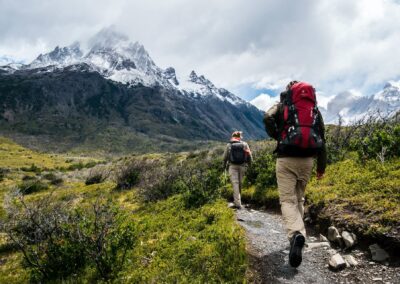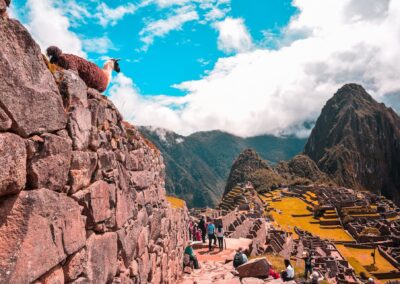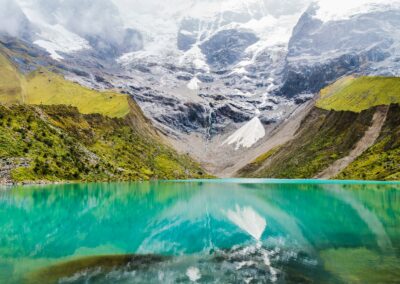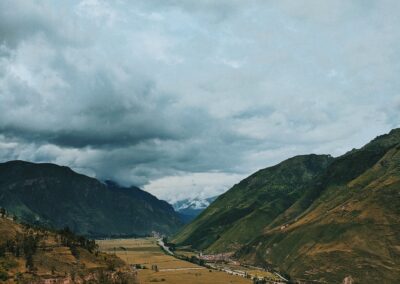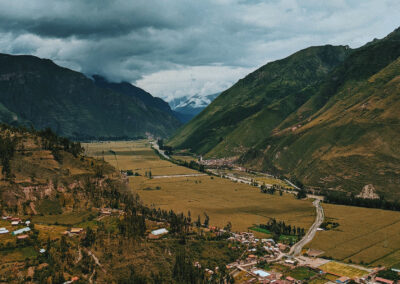Adventure in Cusco and Classic Inca Trail
13 Days / 12 Nights
ACTIVITIES
Hike, Camping, Zipline
DURATION
9 Días / 8 Noches
TIPO
Adventure / Hike
LOCATION
Soraypampa, Machu Picchu, Cusco
Introduction
The Adventure in Cusco and the Classic Inca Trail 13 days and 12 nights is a new proposal to be able to mix two of the best experiences in the city of Cusco, the walk and the adventure.
This experience is intended for all people who have an adequate and optimal state of health in the face of the necessary requirement, you can do it individually to be able to meet new people, as a couple or with friends with whom to share emotions and also as a family to live a unforgettable adventure.
Get inspired for your next vacation with testimonials from traveling customers like you!
Why book this tour?
Experience the adrenaline of the Via Ferrata and the Zipline.
Get to know the hotel suspended on the edge of the mountain, the Sky Lodge.
Enjoy the flavors of Peruvian gastronomy in the Sacred Valley.
Surprise yourself with the circular terraces of Moray.
Get to know the Magical Humantay Lagoon.
Overcome your limits and reach the top of Abra Salkantay.
Enjoy the beautiful and relaxing Hot Springs.
Tour the beautiful Inca citadel and surroundings.
Enjoy the magical train ride in its various classes.
Capture the best shots from the House of the Guardian.
Taste and participate in the preparation of food.
Fall in love with the Inca culture with its living history.
Summary Itinerary
Day 01: Welcome to the city and transfer to your Hotel
- (At agreed time) Llegada a la ciudad y traslado al valle sagrado.
- Hotel night in Urubamba
Day 02: Via Ferrata + Zip Line
- 09:00 – 09:30 Pick up from your hotel and transfer to the Pachar sector.
- 09:30 – 13:30 We will have a short emotional talk with an instructor who will give us the guidelines and advice that we must follow to carry out both activities, after putting on the safety equipment we will begin with the ascent of 400 meters with the help of metal steps, and a line of life that will allow you to be 100% safe. The approximately one-hour ascent will take you to a suspension bridge, and to enjoy a delicious box lunch in the condors' nest, the highest part of the circuit. The mountain will be descended through 6 lines that measure between 700 meters and 250 meters, the shortest.
- 14:00 – 15:30 We will return in our transport to Urubamba where we will have a delicious lunch with typical dishes of the region and then the afternoon free at our hotel to enjoy the wonderful Sacred Valley.
- Hotel night in Urubamba
Day 03: Maras Moray by Bicycle
- 09:00 – 10:00 Pick up from your hotel in Cusco in our transport and we start the trip towards Chinchero.
- 10:00 – 13:00 From here we cycle in the direction of Lake Huaypo, before discovering the agricultural site of Moray, the colonial town of Maras and then the salt mines of Maras, where we will see the process of collecting salt, a precious mineral during the Inca border. and then at the time of the Colony.
- 13:00 – 17:00 Later we will complete our circuit by a beautiful descent to the town of Urubamba, in the lower part of the valley, next to the sacred river of Vilcanota where our mobility will wait for us to return to Cusco in the afternoon.
- Hotel night in Cusco
Day 04: Cusco – Soraypampa (Salkantay Trek)
- Departure from 06:30 a.m. We depart from Cusco, passing through the towns of Izcuchaca and Limatambo, arriving at Mollepata where we will be at approximately 9:00 a.m. where we will have our breakfast, then we will prepare to continue until we reach Soraypampa where our first camp will be. In the afternoon we will make the walk to the Humantay lagoon for approximately 2 hours.
- Night in Camping
Day 05: Soraypampa – Snowy Salkantay – Chaullay (Salkantay Trek)
- At 7:00 a.m. we will have breakfast and then continue with our walk, crossing the entire Collpabamba valley where we will have lunch, then we will resume the walk entering the landscape of the jungle, in this section. We will appreciate formations of the rivers that later become tributaries of the Urubamba River, a variety of Orchids and a waterfall of great magnitude and also this day we can appreciate the majestic Salkantay, we arrive at Chaullay where we will spend the second night.
- Night in Camping
Day 06: Chaullay – Sahuayaco Beach – Santa Teresa (Salkantay Trek)
- Continuing our walk after a comforting breakfast, we will begin our walk appreciating a variety of coca crops, considered the sacred leaf of our ancestors, which is currently cultivated in tropical areas. In this last section, we will descend to Playa Sahuayaco and from there to Santa Teresa where we will spend the night. Here we will say goodbye to our Logistics team and horses, from now on each one is responsible for their hand luggage.
- Night in Camping
Day 07: Santa Teresa – Aguas Calientes
- The sunrise will be within a tropical area full of history and nature, there our breakfast awaits us ready to taste and then we will continue our trip towards Aguas Calientes, reaching this town will take us approximately 7 hours, passing through the well-known Hydroelectric rest center, making stops in different places to simply appreciate the landscape and its surroundings full of waterfalls with impressive falls which come from the glaciers, arriving in the afternoon at the mentioned town that is popularly known as "Aguas Calientes".
- Hotel night in Aguas Calientes
Day 08: Aguas Calientes – Machu Picchu – Cusco
- 07:00 – 08:00 Bus ride from Aguas Calientes to Machu Picchu.
- 08:00 – 10:30 Guided tour of the main attractions within the Historic Sanctuary of Machu Picchu.
- Return bus to Aguas Calientes and free time in Aguas Calientes to have lunch, visit the town (on your own).
- 16:22 – 18:05 Return train from Aguas Calientes to Ollantaytambo. (Expedition Service).
- 18:10 – 20:00 Travel by Van from Ollantaytambo to your hotel in Cusco.o.
- Hotel night in Cusco
Day 09: Day of your departure
- (At agreed time) Transfer from your hotel to the airport (2 hours before your flight).
Detailed Itinerary
Our experience allows us to know the main places in the city of Cusco, enjoying the comfort in each space and the necessary security, the places that we will know are:
- Maras: The town of Maras was founded by the Spanish in the year 1556, its importance during the viceroyalty stood out (it was the main supplier of salt in the Andes), as evidenced by its church dedicated to San Francisco de Asís and the mansions that still preserve the almost intact shields belonging to each family of the indigenous nobility on their facades, even with the passage of time you can read the date inscribed on which they were built on many of them. The Salinas de Maras on the other hand has an older history belonging to the Inca period, they are located on the slope of the hill, these are shaped like pools that are crossed by a small stream that provides salt water to each one. The use of the Salt of Maras is varied since it is now commercialized and can be used in medicinal baths, personal consumption and others. Its collection process is passed from generation to generation, but it is managed in a communal way where all the inhabitants participate.
- Moray: A particular Archaeological complex that today still causes great curiosity when visited due to the shape of the design it has. They are circular terraces that simulate in some way the Amphitheater that we find in the Roman culture, according to the investigations that were made since the 90s, this place fulfilled the function of adapting the seeds of the various products in the different altitudinal floors that the Valley has. Sacred, this allowed for a great variety of products in each place and at the same time gave the possibility of new varieties. With the use of spectral thermometers, it was also determined that each circular terrace has a different temperature, which allows adaptation to be more efficient since the climate in the entire region is always changing.
- Humantay Lagoon: It bears the name of Humantay because of its location at the base of the snow-capped mountain that bears this name. The formation of this lagoon is due to the melting produced over the years and its peculiar coloration is produced by greenish microalgae, possibly of the species Microcystis aeruginosa and Oscillatoria, these mixed with the crystallinity of the water and solar radiation. produce the particular effect that draws everyone's attention. possibly of the species Microcystis aeruginosa and Oscillatoria, these mixed with the crystallinity of the Water and the solar radiation produce the particular effect that attracts everyone's attention.
- Abra Salkantay: It is the highest point of our entire experience, located at 4650 msnm. From this point we have a privileged view of the Salkantay mountain and its entire valley. Due to the height at which it is located, it is natural that the climate is extreme and icy due to the presence of snow-capped mountains. A tradition of walkers is the construction of apachetas in this place, which are stones superimposed one on top of the other as a symbol of respect towards the mountains as the Incas used to do.
- Cocalmayo: It is located next to the Urubamba River and a small mountain. It is a perfect place for all visitors who make the journey from Salkantay to have a well-deserved rest in these pools fed by natural hot springs surrounded by varied vegetation. We found 3 pools of different sizes with a temperature between 38 and 44 ºC. We also find cold showers with water from the Uripata lagoon and it is very refreshing.
- Guardian House: This beautiful place is located in the highest area of the Inca citadel on the Agricultural Area. Its function was to control the entrance to the Inca city and review the entire agricultural and urban area. From here you can see a panoramic view of the entire citadel and the entrance to the old Inca trail. It has three walls: In the central wall we find three large windows, which allow us to easily observe the entrance to the Inca trail and the Inca bridge, the only means of communication with the outside world. We can also see how the Incas covered the enclosures with a ichu roof.
- Llacta Punku: It is the income for the urban sector, it is located limited by a deep excavation. This sector is located from the cemetery by a long staircase towards the peripheral neighborhoods, it has a system of points to hold a wooden door, in person and not as an element of restriction or security since the city can also be accessed by other roads.
- Ceremonial Plaza: It is a set of enclosures made around a quadrangular patio, you can see three polygonal walls, made with immense stone pieces assembled perfectly. The presence of three windows and two niches on each side stands out. It is considered that the function of these windows was probably purely religious, next to this we can find a different enclosure called The House of the Priest.
- Temple of the Sun (1:00 p.m. – 4:00 p.m.): This enclosure has a finely polished two-story structure: the first is semi-underground and the second features a beautiful semi-circular wall with perfect finishes, with an incline towards its interior due to what is called “Torreón”. It was used to celebrate religious ceremonies, especially during the months of June and December, special dates for the Solstices. This Tower has two trapezoidal windows, one oriented towards the most extreme point of the winter solstice that takes place on June 22 and the other oriented towards the Puerta del Sol (Intipunku) for the summer solstice that occurs on June 22. from December. In the middle of this architecture we can find a central rock, polished in the shape of an altar that was used for the ceremonies of interpretation of the path that the sun followed. It is built on a large rock, under which there is a small cave, which has been worked and covered with a thin wall, this is because it probably fulfilled the function of a mausoleum, because it has niches of a moderate size, where they placed the mallquis or mummies where they were worshipped.
- Temple of the 3 windows: This enclosure has three polygonal walls, built with enormous stone pieces perfectly assembled, highlighting 3 windows and 2 niches at each end. The function they had was religious magic and not only aesthetic. It was Hiram Bingham who carried out excavations in the front part of this temple, finding a large amount of fractured ceramics and highlighting the detail of the bases of this temple with a depth of more than three meters, here is also the possible symbolic figure of the head of a carved llama, this image is allegorical to the camelid because of the importance it had as a beast of burden, supplier of meat and clothing to the Incas.
- Main Temple: It has a finely polished structure with beautiful finishes, an enclosure framed by only three walls, each of the large pieces have been carefully crafted. The central wall has a dimension of 11 meters. Behind the Main Temple there is an enclosure whose function was probably also for religious use according to the records obtained and whose stones have no less than 32 angles, which makes its meaning quite mysterious.
- Intihuatana (07:00 a.m. – 10:00 a.m.): It bears his name in Quechua which translated means "where the sun hangs“, is an area that corresponds to one of the highest sectors of the Urban Zone. This is the most important area of Machu Picchu, at the top of this area we can find a huge sculpture made and carved with flat surfaces, a column of 66 cm. tall and with finely carved faces that complement the sculpture. The total space of the Intihuatana measures 8.60 meters and 1.76 meters high. The Intihuatana, is one of the most enigmatic objects of Machu Picchu, it is related to the sunrise and the mountains. The movement of the Sun causes projections of shadows at different times, this served to recognize and interpret them in different periods of the year.
- Sacred Rock: It is a carved stone that resembles the silhouette of a mountain. It is located next to the control point to access the Huayna Picchu Mountain, made up of two Huayrana-type environments (three-walled environment), with very high ceilings that face each other forming a small, almost square plaza. This rock has an important location, since it is on the path that leads to two very important sites such as Huayna Picchu and the Temple of the Moon.
- Water mirrors: Its name is in relation to the enclosure where they are found as well as to the constructions that are in the place. It is a wide sector, with a single access door, which is why it is attributed to be an Acllahuasi or House of Selected Women who were dedicated to spinning, cooking and preparing chicha or acja, for the privileged class. Among the possible functions attributed to this space are: - In one of its rooms, you can see two circular rock projections, which have the shape of mortars, they were probably used to grind grains or prepare dyes. - It is also given the name of 2 water mirrors, due to the fact that in the rainy season they agglomerate with water and allow us to see the reflected stars.
- Temple of the Condor (10:00 a.m. – 1:00 p.m.): It is a wide set of constructions, made taking advantage of the irregular shapes and on a cave that was notoriously used for ceremonies. The condor was an animal worshiped during Inca times and associated with the divinity of the mountains. The area is delimited by stairs and finely carved walls, its access is controlled by a double jamb door, which shows the hierarchy and the activities that took place in this area, it presents a great variety of closed and open environments with one and two levels. In the central patio it has as its main point, a carved rock, where the representation of the head and part of the body of a condor can be clearly distinguished. You can see the head, beak and eyes, as well as the necklace of white feathers of the Royal Condor, with the body projected towards the interior of the cave, which subtly joins two natural rocks. In this sector you can see the clear union of natural rocks with others worked by man, seeking to represent a tutelary deity. In the underground cave (the body of the Condor) offerings, ceramics and bone remains of camelids were found, which confirm the quality of a "ceremonial center" where offerings were made. In front of the temple of the condor enclosure we will find a 2-story structure that has two entrance doors, the second level is flush with the patio of the condor and by observation it must have served as the enclosure of the priest, in charge of the worship of the Condor. You descend to the first level by a staircase that connects to other rooms. In an environment attached to it, sectors for raising animals were found, other stairs lead to a lower platform.
- Water sources: We can see a large staircase next to which runs a system of 16 waterfalls, most of them carefully carved in polygonal blocks and surrounded by gutters made in the rock. The water comes from a spring in the heights of the Machu Picchu mountain that was channeled in Inca times. A separate channel at the top of the mountain also associates the seepage of rain from the mountain and diverts it to the main channel.
What's Included?
Included
Cusco and Maras Moray by Bicycle:
-
Tourist transport: Travel by tourist transport to get to Pacha.
-
Welcome transfer: It is done in private transport, from the airport to the hotel in Urubamba.
-
Detailed briefing: It takes place before the start of the service (The briefing is a complete orientation, explaining everything about the tour. In addition, any questions you may have about it will be clarified).
-
Small groups: We always handle an adequate amount of people, personalized shared tour style.
-
First level guide: Professional tour guide specialized in Cultural tourism (English/Spanish).
-
Equipment: Necessary safety elements such as gloves, helmet and specialized bicycle.
-
Box Lunch: Includes a small portion of food (portion of rice, rolled chicken and vegetables), fruit, frugos, energy bar, water for your canteen and a sandwich (ham and cheese).
-
Tourist transport: Travel by tourist transport to visit the towns of Maras, Moray and Urubamba.
-
Entrance tickets: Partial Tourist Ticket (Moray) and entrance ticket to Maras.
-
3 star hotel in Cusco and Urubamba: 09 nights in a central hotel that has a private bathroom, hot water, comfortable rooms, Wi-Fi, luggage storage and breakfast the next day.
Zip Line and Via Ferrata:
-
Tourist transport: Travel by tourist transport to get to Pachar.
-
First level guide: Professional tour guide specialized in adventure tourism (English/Spanish).
-
Equipment: Necessary safety elements such as harness, helmet, ropes and specialized gloves for zip line and via ferrata.
-
Box Lunch: Includes a small portion of food (portion of rice, rolled chicken and vegetables), fruit, frugos, energy bar, water for your canteen and a sandwich (ham and cheese).
-
Buffet lunch: It is a buffet in Urubamba, with a variety of Peruvian and local food.
Salkantay Trek
-
Transport Cusco-Mollepata: On the morning of the start of the tour, we pick you up in private transport, with the presence of the guide. We will go from the city to the control point of the walk.
-
Entrance to Mollepata: The entrance ticket to this area, control station of the Salkantay Trail is included.
-
Transportation to Soraypampa: This point is the beginning of the walk.
-
Experienced guide: Bilingual professional specialized in Salkantay Trek, with official authorization.
-
First aid box: First aid kit, oxygen balloon.
-
Muleteers and horses: To move the kitchen equipment, food and luggage of the passenger (we include up to 5 kg of luggage per person).
-
Comfortable tents: They are type 4 seasons, in excellent condition. 2 person tents for 1 passenger and 4 person tents for 2 passengers. Also inflatable mattresses, waterproof with thermal insulation.
-
Fleece sheets: They fit in your sleeping bag and are great for cold nights.
-
Canes: They are very convenient to save energy when walking and also to have more balance.
-
Complete household: Plates, cups, glasses, cutlery, etc., all of them made of reusable material (surgical steel). We contribute to reduce environmental pollution by disposable plastics.
-
Kitchen staff: Specialist cooks. For groups larger than 4 people, we will have an experienced kitchen assistant.
-
Feeding: 04 breakfasts, 04 lunches, 03 dinners during the tour. We provide vegetarian, vegan and other diets at no additional cost, upon request during the reservation.
-
Wake up tea: Every day, we bring a delicious hot infusion to your tent.
-
Sunset Tea: Daily, arriving at the camp we offer you a relaxing herbal infusion, tea or coffee, accompanied by rolls, butter and jam.
-
Varied snacks: We give him in a small cloth bag every morning: a fruit, an energy bar or cookie and candies, so that he can consume them during the day.
-
3 star hotel in Aguas Calientes: Central hotel that has a private bathroom, hot water, comfortable rooms, Wi-Fi, luggage storage and breakfast the next day.
-
Uphill bus: From the town of Aguas Calientes to Machu Picchu for the guided tour.
-
Entrance tickets: Both for the Inca Trail and for the visit to the citadel of Machu Picchu.
-
Return bus: From the citadel of Machu Picchu to the town of Aguas Calientes, after the guided tour.
-
VTrain ride: From Aguas Calientes to the train station in Ollantaytambo. (Expedition Service).
- Sale of snacks on board: Alcoholic and non-alcoholic drinks, sweets.
- Sanitary facilities: At the station and inside the train.
- Souvenir sale: Baby alpaca collection.
-
Private transport: From the train station in Ollantaytambo to your hotel in the city of Cusco.
-
Final transfer: We take you from your hotel to the airport, on the day you indicate (prior coordination with us).
Tambien se incluye a solicitud del cliente:
-
Bags (duffel bags): Para que lleve su equipaje.
-
Waterproof poncho: Para protección contra las posibles lluvias y el viento.
Not Included
-
Airfare: Both international and national.
-
Transportation: From Playa to the town of Santa Teresa.
-
Breakfast of the first day. You will need to reserve it at your hotel early, before we come to pick you up.
-
Sleeping bag: It is essential that you have one, that resists up to -18°C. They are stuffed with feathers (we rent them for US$25.00).
-
Entrance to the Huayna Picchu mountain: This walk must be reserved separately, at an additional cost and well in advance.
-
Personal expenses and Tips: How to buy handicrafts, clothes, drinks, etc. Tips are not included either, these are voluntary according to the service received.
-
Travel insurance: It is a very important requirement for your safety and protection, for example in case of a medical emergency, the costs will be much lower.
What To Bring?
Trekking Articles
Mochila (30 o 50 litros), cantimplora, trekking shoes, casaca impermeable.
Useful Elements
Pasaporte, efectivo en soles (compras adicionales).
Useful Items
Passport, Cash in soles, Camera, charging cord, Extra batteries.
Clothes
Small backpack, rain poncho (January and February – rainy season), warm clothes.
Health and Care
Sunscreen, sunglasses, insect repelent, sun hat, Small towel, Bottled water, Personal medication.

DIFFICULTY LEVEL
Agotador

